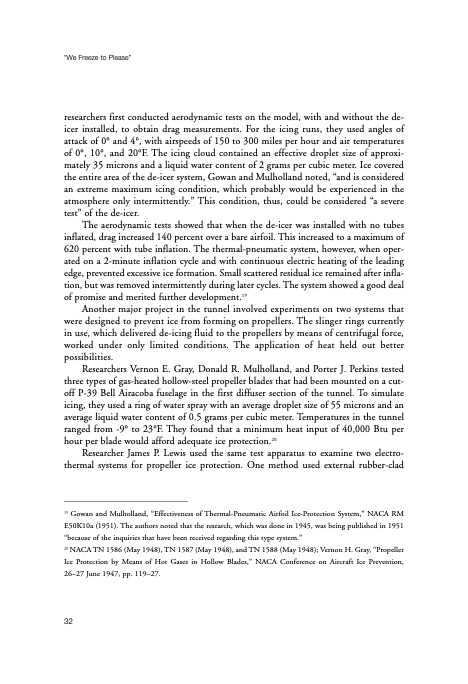
PDF Publication Title:
Text from PDF Page: 045
“We Freeze to Please” researchers first conducted aerodynamic tests on the model, with and without the de- icer installed, to obtain drag measurements. For the icing runs, they used angles of attack of 0° and 4°, with airspeeds of 150 to 300 miles per hour and air temperatures of 0°, 10°, and 20°F. The icing cloud contained an effective droplet size of approxi- mately 35 microns and a liquid water content of 2 grams per cubic meter. Ice covered the entire area of the de-icer system, Gowan and Mulholland noted, “and is considered an extreme maximum icing condition, which probably would be experienced in the atmosphere only intermittently.” This condition, thus, could be considered “a severe test” of the de-icer. The aerodynamic tests showed that when the de-icer was installed with no tubes inflated, drag increased 140 percent over a bare airfoil. This increased to a maximum of 620 percent with tube inflation. The thermal-pneumatic system, however, when oper- ated on a 2-minute inflation cycle and with continuous electric heating of the leading edge, prevented excessive ice formation. Small scattered residual ice remained after infla- tion, but was removed intermittently during later cycles. The system showed a good deal of promise and merited further development.19 Another major project in the tunnel involved experiments on two systems that were designed to prevent ice from forming on propellers. The slinger rings currently in use, which delivered de-icing fluid to the propellers by means of centrifugal force, worked under only limited conditions. The application of heat held out better possibilities. Researchers Vernon E. Gray, Donald R. Mulholland, and Porter J. Perkins tested three types of gas-heated hollow-steel propeller blades that had been mounted on a cut- off P-39 Bell Airacoba fuselage in the first diffuser section of the tunnel. To simulate icing, they used a ring of water spray with an average droplet size of 55 microns and an average liquid water content of 0.5 grams per cubic meter. Temperatures in the tunnel ranged from -9° to 23°F. They found that a minimum heat input of 40,000 Btu per hour per blade would afford adequate ice protection.20 Researcher James P. Lewis used the same test apparatus to examine two electro- thermal systems for propeller ice protection. One method used external rubber-clad 19 Gowan and Mulholland, “Effectiveness of Thermal-Pneumatic Airfoil Ice-Protection System,” NACA RM E50K10a (1951). The authors noted that the research, which was done in 1945, was being published in 1951 “because of the inquiries that have been received regarding this type system.” 20 NACA TN 1586 (May 1948), TN 1587 (May 1948), and TN 1588 (May 1948); Vernon H. Gray, “Propeller Ice Protection by Means of Hot Gases in Hollow Blades,” NACA Conference on Aircraft Ice Prevention, 26–27 June 1947, pp. 119–27. 32PDF Image | History of NASA Icing Research Tunnel

PDF Search Title:
History of NASA Icing Research TunnelOriginal File Name Searched:
sp4226.pdfDIY PDF Search: Google It | Yahoo | Bing
NFT (Non Fungible Token): Buy our tech, design, development or system NFT and become part of our tech NFT network... More Info
IT XR Project Redstone NFT Available for Sale: NFT for high tech turbine design with one part 3D printed counter-rotating energy turbine. Be part of the future with this NFT. Can be bought and sold but only one design NFT exists. Royalties go to the developer (Infinity) to keep enhancing design and applications... More Info
Infinity Turbine IT XR Project Redstone Design: NFT for sale... NFT for high tech turbine design with one part 3D printed counter-rotating energy turbine. Includes all rights to this turbine design, including license for Fluid Handling Block I and II for the turbine assembly and housing. The NFT includes the blueprints (cad/cam), revenue streams, and all future development of the IT XR Project Redstone... More Info
Infinity Turbine ROT Radial Outflow Turbine 24 Design and Worldwide Rights: NFT for sale... NFT for the ROT 24 energy turbine. Be part of the future with this NFT. This design can be bought and sold but only one design NFT exists. You may manufacture the unit, or get the revenues from its sale from Infinity Turbine. Royalties go to the developer (Infinity) to keep enhancing design and applications... More Info
Infinity Supercritical CO2 10 Liter Extractor Design and Worldwide Rights: The Infinity Supercritical 10L CO2 extractor is for botanical oil extraction, which is rich in terpenes and can produce shelf ready full spectrum oil. With over 5 years of development, this industry leader mature extractor machine has been sold since 2015 and is part of many profitable businesses. The process can also be used for electrowinning, e-waste recycling, and lithium battery recycling, gold mining electronic wastes, precious metals. CO2 can also be used in a reverse fuel cell with nafion to make a gas-to-liquids fuel, such as methanol, ethanol and butanol or ethylene. Supercritical CO2 has also been used for treating nafion to make it more effective catalyst. This NFT is for the purchase of worldwide rights which includes the design. More Info
NFT (Non Fungible Token): Buy our tech, design, development or system NFT and become part of our tech NFT network... More Info
Infinity Turbine Products: Special for this month, any plans are $10,000 for complete Cad/Cam blueprints. License is for one build. Try before you buy a production license. May pay by Bitcoin or other Crypto. Products Page... More Info
| CONTACT TEL: 608-238-6001 Email: greg@infinityturbine.com | RSS | AMP |